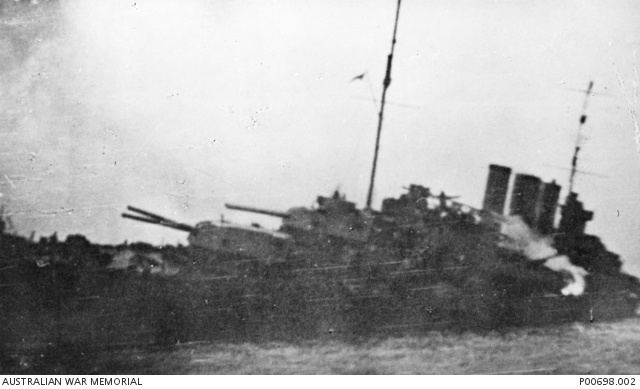70th Anniversary of the loss of HMAS Canberra
Today marks the 70th anniversary of the loss of HMAS Canberra. On 9th August 1942, the cruiser came to a catastrophic end in the Pacific during the Battle of Savo Island. Captain Frank Edmund Getting was in command at the time. He had a long association with the Navy. His story, and that of HMAS Canberra, was uncovered whilst scanning the Reports of Proceedings for HMAS Canberra.
In December, 1912, Getting entered the Royal Australian Naval College. According to routine six-monthly confidential reports submitted by Commanding Officers, Getting was rated highly amongst his superiors. In December 1940, during his service aboard the armed merchant cruiser ship, Kanimbla, he was promoted to captain. In his report of March 1940, Admiral Percy Noble, writes,
Although this officer has only served with me for a short time, he has so favourably impressed me with his ability, keenness and power of command … He has a fine physique and a good manner and appearance. His whole heart seems to be in the Service and I am sure he will do very well.
Captain Getting took command of HMAS Canberra on Wednesday 17 June 1942. Less than two months later, both he and the Canberra found themselves supporting the American landings at Guadalcanal and Tulagi in the Pacific. The objective: to capture the almost complete Japanese airfield at Lunga Point, safe-guarding American/Australian supply lines.
The landing was successful. The airfield was captured and re-named “Henderson Field”. Despite the loss, the Japanese launched air attacks, and within two hours sent a cruiser force for the Allies.
American ships USS Chicago, Bagley and Patterson alongside HMAS Australia and Canberra patrolled the area to the south of Savo Island. Rear Admirals Crutchley (in command of the combined forces of Australian and American cruisers and destroyers at Guadalcanal) and Turner, concluded that the force was proceeding onto Rekata Bay, where they may launch an attack. In the early hours of 9 August 1942, the Japanese force approached undetected. At 1.50pm a flare was seen dropping south-west of Savo Island. At 1.55pm Canberra was identified as one of the ships on fire.
Struck by two torpedoes on her starboard side and over twenty salvoes of 8-inch shellfire, Canberra lost power and the ship was listing. Many died or were seriously wounded during the attack. Survivors were later transferred to US Ships Patterson and Blue.
In his account of Canberra’s loss, Stoker John Oliver Rosynski describes the Japanese ships approaching the Canberra and the chaos that ensued. He goes on further, recounting how Captain Getting stood on the bridge, slowly and calmly giving orders.
About ten minutes into the action, Surgeon Commander Downward arrived on the bridge. Captain Getting was seriously wounded and in need of medical attention. Downward states,
The Commander [J.A. Walsh] was standing on the port side of the bridge. The Gunnery Officer’s body was on the port side. I spoke to the Captain but he refused any attention at all. He told me to look after the others.
Captain Getting died on board the USS Barnett on passage to Noumea and was buried at sea on 9 August. Of the 819 of those serving on board, 193 were casualties. In the final paragraph of his account, Rosynski writes,
They say that memory dims, but I’m sure in after years come what may, I’ll always have a thought for that ship, even though she lies buried for all time deep in the mud and drifting sands of the Pacific. She will, in my mind at least, sail the gallant “Canberra”.
More information:
Gill, G Herman, Royal Australian Navy, 1939-1942, Australia in the war of 1939-1945, Series 2 (Navy), vol. 1, Canberra, 1957. Retrieved from: /collection/records/awmohww2/navy/vol2/awmohww2-navy-vol2-ch5.pdf
HMAS Canberra Reports of Proceedings June 1940 – June 1942, Australian War Memorial, AWM78 82/2. Retrieved from: /collection/records/awm78/82/
Papers of Rosynski, John Oliver (Stoker), Australian War Memorial, PR01715
GETTING F E [Officers (RAN) personal record - Frank Edmund Getting], National Archives of Australia, A3978 GETTING F E. Retrieved from: http://www.naa.gov.au

